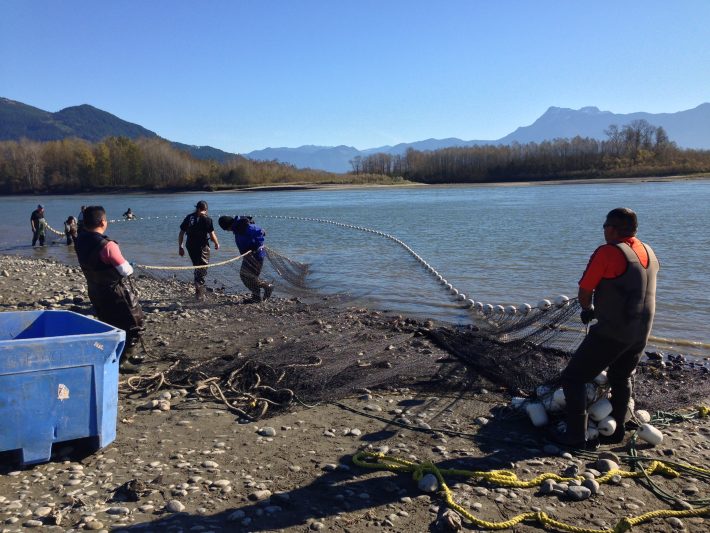Press Release: Hidden salmon diversity sustains First Nations fisheries
Simon Fraser University Press Release
A new study from Simon Fraser University, published in Journal of Applied Ecology, shows that high biodiversity of salmon increases the consistency of catches from year-to-year and extends the season for fresh fish in First Nations fisheries.

Salmon-folios
Instead of analyzing market returns of different financial portfolios, this study examined First Nations fisheries with different “salmon-folios”. Like a well-balanced financial portfolio that can smooth market fluctuations, fisheries that caught a more diverse portfolio of salmon populations and species were more stable through time.
We found that fisheries that could access a higher number of salmon populations had up to 3.8 times more stable catch and 3 times longer fishing seasons than fisheries with access to fewer populations
says Holly Nesbitt, lead author of the study and a Masters student at the time of the study.
For this work, Nesbitt and Moore analyzed 30 years of catch data from Fisheries and Oceans Canada from 21 different First Nations fisheries that span throughout the Fraser River watershed.
Hidden salmon biodiversity
“One of the surprising findings was that catch stability was mainly driven by hidden population diversity within salmon species, while the number of different salmon species had a smaller effect,” explains Nesbitt.
Large salmon watersheds like the Fraser River don’t just contain five species of Pacific salmon such as Chinook and sockeye, but within each of these species there can be dozens of locally-adapted and genetically-unique populations of salmon.
“We know that climate change is making the world increasingly volatile; this research illustrates how protecting existing biodiversity can help dampen this variability and support food security for indigenous peoples,” said co-author Jonathan Moore, Liber Ero Chair of Coastal Science and Management at SFU. “On the other hand, these findings also indicate that loss of salmon biodiversity can increase the volatility of fisheries, even if they are 100s of km downstream.”
The results from this study may have implications for aboriginal rights and title in Canada, especially with the Canadian government’s recent endorsement of the UN declaration on the Rights of Indigenous Peoples.
41% of First Nations people are food insecure and 91% state that they want to consume more traditional foods like salmon*, according to a recent study in BC.
“First Nation peoples across BC have been and are forever woven together through the sacred food source of Wild Salmon,” says Bob Chamberlin, Vice President of the Union of BC Indian Chiefs and Chairman of the First Nation Wild Salmon Alliance, unaffiliated with the study.
According to First Nations and political leaders, this study provides further evidence for why protection of salmon habitat can pay dividends.
“The Government of Canada must step up and enact not only the Recommendations of the Cohen Commission Report, but the ‘Principles’ must be enacted upon coast wide,” explains Chamberlin.
Protection of the broadest genetic diversity of Wild Salmon stocks will help them provide for our future generations, a component of our Constitutionally-protected Aboriginal Rights.
Fin Donnelly, Member of Parliament for Port Moody-Coquitlam (unaffiliated with study), states that, “Moore and Nesbitt’s research clearly demonstrates diversity is key, especially when it comes to salmon survival – it verifies the necessity of habitat protection. What it also shows is the need for government to embrace a watershed, or whole systems approach, in decision-making.”
Links and related materials
Nesbitt, H.K., and J.W. Moore. 2016. Species and population diversity in Pacific salmon fisheries underpin indigenous food security. Journal of Applied Ecology. DOI: 10.1111/1365-2664.12717
http://onlinelibrary.wiley.com/doi/10.1111/1365-2664.12717/full
For more information and supporting pictures, see http://www.jonwmoore.org/#!news/crgd
For media inquiries, please contact:
Holly Nesbitt, nesbitt.holly@gmail.com, 604 -808-3626
Jonathan Moore, jwmoore@sfu.ca, 604-971-3722
*Chan, L., Receveur, O., Sharp, D., Schwartz, H., Ing, A. & Tikhonov, C. (2011) First Nations Food, Nutrition and Environment Study (FNFNES): Results from British Columbia (2008/2009). Prince George.
Like what we stand for?
Support our mission and help develop the next generation of ecologists by donating to the British Ecological Society.